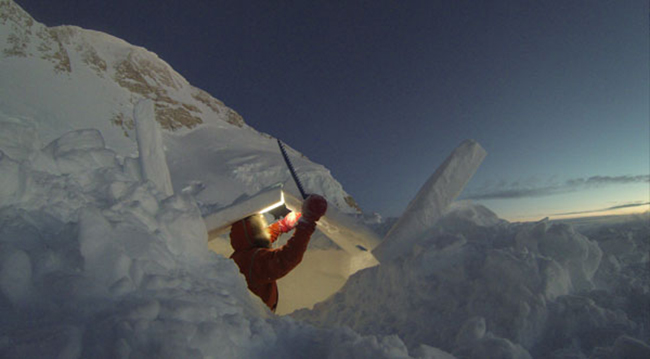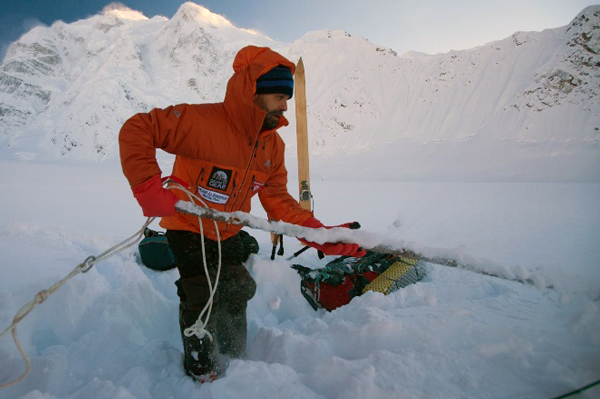
Climber Lonnie Dupre has returned to Talkeetna after becoming the first soloist to ever summit Denali in the month of January.
Lonnie Dupre’s historic climb began on December 18th, and he summited Denali on January 11th just after 2:00 pm. This was Dupre’s fourth attempt at the unprecedented feat of being the first person to climb the mountain solo in January. Veteran climber Willi Prittie says January is a tough month for climbing in Alaska, when the longest periods of daylight stretch just past six hours.
“You’ve got to be really on top of your self-care, your logistical stuff, and take advantage of every little bit of daylight that you have, and it isn’t any too much in something like January,” Prittie said.
Like most climbs on North America’s tallest peak, the weather factored into Lonnie Dupre’s expedition. He says one big difference between this year and his prior attempts was the amount of snow.
“The hardest thing, hands down, on this trip for me was the deep snow,” Dupre said. ”We had very deep snow right out of base camp and all the way up to the top of the mountain, almost. And dragging a, in the begining, a 194 pound sled through that deep snow–it doesn’t slide. It just plows.”

Dupre was helped through the snow by his homemade skis, which are eight feet long and four inches wide. He says the snow was due to warm weather and low-pressure in the Alaska Range. Lonnie Dupre says that warmth can actually be a problem.
“I would much, much, much prefer thirty-or-forty-below zero day in and day out, because you’re drier, you can operate better, and usually when it’s that cold you don’t have the winds with that,” Dupre said.
One time that the winds did play a major role in the climb was when Lonnie Dupre was between 10,000 and 11,000 feet of elevation. He says the wind picked up and started blowing lots of snow. He stashed much of his gear and went ahead to establish his camp. Then the weather really moved in and caught Dupre with meager supplies.
“Just a day and a half’s worth of food and twenty-two ounces of fuel, which is about three days worth of fuel,” he said. “I had to stretch the food and the fuel for five and a half days, so I was a scrawny, cranky, kind of scared individual.”
Lonnie Dupre says he was scared because he knew there was no way for help to arrive if conditions didn’t improve. He says one or two more days might have seen him succumb to lack of food or warmth. Eventually, Mother Nature relented, and Dupre was on his way again.
As he reached the higher section of Denali, Lonnie Dupre says the forecast called for a window of two days with weather good enough to perhaps try to reach the summit. In the dark hours of the morning on January 11th, he made his run. Right around 2:00 p.m., Dupre saw what he had spent four years trying to reach, the official marker for the highest point in North America.
“I saw that, and I just broke down a little bit, because it’s been four years of hard work,” Dupre said. “And I spent ten minutes, no longer, on the top. I gave a good look around, twice. Then, I started high-tailing out of there.”
The wind was picking up yet again, but Lonnie Dupre was able to get back to his camp and his gear before it got too rough. Then, it was a race against weather moving in from the south. Dupre made it to base camp at 7,200 feet on December 14, but high winds prevented his pick-up by airplane. The next day, though, Talkeetna Air Taxi pilot Paul Roderick says the weather, which was not forecast to be favorable, opened up.
“I thought we might have a little window to work with…but not this good,” Roderick said. ”It was actually generally improving. It was still windy, but actually [at base camp] it was calm and twenty degrees. It was just perfect conditions. It couldn’t have been better.”
Lonnie Dupre, after cold, snow, storms, and wind, had achieved his goal and returned safely to the lowlands. He was greeted by sponsors, friends, and members of Talkeetna’s climbing community.
With a successful trip behind him, Lonnie Dupre says he will likely come back to Talkeetna, but probably for slightly less strenuous activities than climbing to the top of the continent by himself during the coldest, darkest period of the year. For now, he’s just happy to be back.
